If you’re new to owning a rice cooker or have recently noticed bubbling during operation, you might be wondering if this is normal. The truth is, rice cookers can bubble during cooking, and it may or may not indicate a problem. In this article, we’ll explore the normal functioning of rice cookers, potential issues that may cause excessive bubbling, and troubleshooting techniques to resolve bubbling problems.
Key Takeaways:
- Rice cookers can bubble during cooking, which may or may not indicate a problem.
- Understanding the normal functioning of rice cookers can help you identify potential issues.
- Practicing essential safety and maintenance tips can ensure proper rice cooker functioning.
- Troubleshooting techniques and preventive measures can resolve and prevent bubbling problems in rice cookers.
Understanding Rice Cooker Operations
Many home cooks have experienced bubbling while using their rice cooker. This can be alarming, especially for those who are new to using these appliances. However, it’s important to understand that some degree of bubbling during operation is normal for most rice cookers.
Rice cookers consist of an inner cooking pot, an outer container, and a heating element. The inner pot is filled with rice and water and placed in the outer container. When the appliance is turned on, the heating element under the outer container heats the water, creating steam that cooks the rice. As the steam rises, it can cause bubbles to form, which in turn can cause the water to boil over if the rice cooker is overfilled or the lid is not properly sealed.
When the rice is almost done cooking, the temperature inside the cooker begins to rise, which can cause the bubbling to increase. This is normal and does not necessarily indicate a problem with the appliance.
If you notice excessive bubbling while using your rice cooker, there are a few things you can do to troubleshoot the issue. First, make sure the appliance is properly assembled and the lid is securely in place. If the lid is loose or not seated correctly, steam can escape and cause the rice to cook unevenly or boil over.
You can also try reducing the amount of rice and water you put in the cooker. Overfilling the pot can cause the water to boil over and create excessive bubbling. To ensure that the rice cooker is working properly, it’s important to follow the manufacturer’s instructions carefully and conduct regular maintenance.
In the next section, we will discuss some essential safety tips to follow when using a rice cooker, as well as some maintenance tips to help ensure that your appliance is working properly.
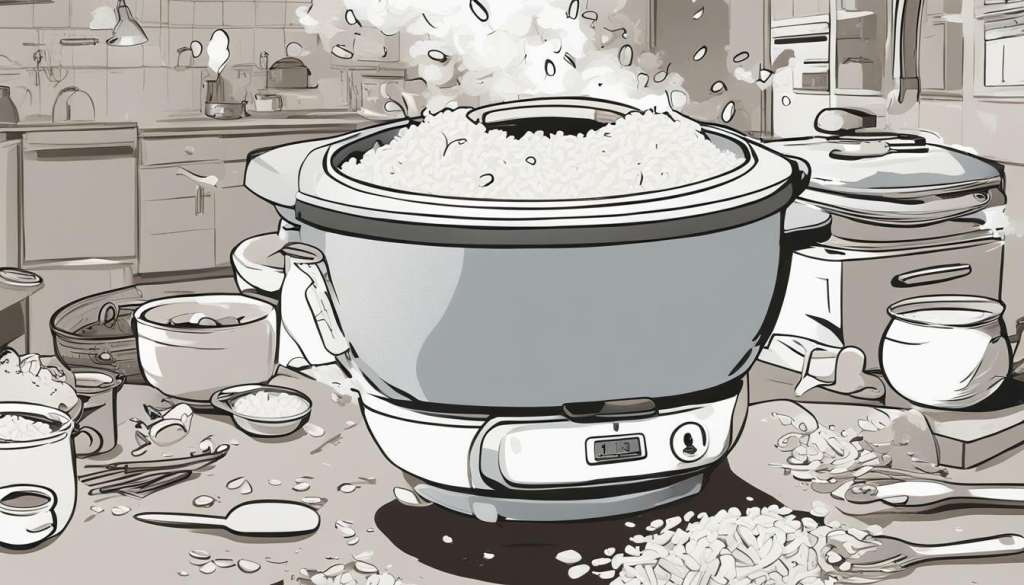
Safety Tips for Rice Cooker Usage
While rice cookers are generally safe to use, improper handling can lead to malfunction or cause accidents. Here are some essential safety tips for proper rice cooker usage:
- Read the Instruction Manual: Before using your rice cooker, make sure to read and understand the user manual. This will familiarize you with all the features and functions of your rice cooker and ensure you use it safely.
- Stay Nearby During Operation: Don’t leave your rice cooker unattended while it’s cooking. This will allow you to monitor the cooking process and prevent any accidents.
- Don’t Overfill: Overfilling your rice cooker can cause it to malfunction, resulting in unevenly cooked rice or even damage to the appliance. Follow the manufacturer’s instructions for the appropriate amount of rice and water to use.
- Keep It Clean: Regularly clean your rice cooker to prevent the buildup of residue or grime, which can compromise its functionality and safety. Follow the manufacturer’s instructions for cleaning and maintenance.
- Don’t Use Metal Utensils: Never use metal utensils, such as spoons or spatulas, in your rice cooker. This can lead to scratches or damage to the appliance’s non-stick coating, which affects its safety and performance.
- Unplug It When Not in Use: Always remember to unplug your rice cooker when it’s not in use. This saves energy and minimizes the risk of accidents.
By following these simple safety tips, you can ensure that your rice cooker operates optimally and safely.
Rice Cooker Maintenance Tips
Proper maintenance is crucial for the longevity and optimal performance of your rice cooker. Here are some maintenance tips to keep in mind:
- Regular Cleaning: Wipe your rice cooker’s interior and exterior with a damp cloth after each use. Make sure to remove any food residue or dirt that may have accumulated on the surfaces.
- Descale the Rice Cooker: Over time, minerals from the water may build up in your rice cooker’s heating element, affecting its functionality. Descale your rice cooker periodically to remove any mineral buildup. Follow the manufacturer’s instructions for descaling.
- Check the Power Cord: Make sure the power cord is in good condition before using your rice cooker. If you notice any frayed wires or other damage, contact the manufacturer for assistance.
- Store It Properly: When not in use, store your rice cooker in a dry and cool place. Avoid exposing it to direct sunlight or extreme temperatures, as this can damage its components and affect its performance.
- Replace Parts When Necessary: If you notice any issues with your rice cooker’s components, such as the lid or the inner pot, contact the manufacturer for replacement parts. Don’t attempt to repair the rice cooker yourself, as this can be dangerous.
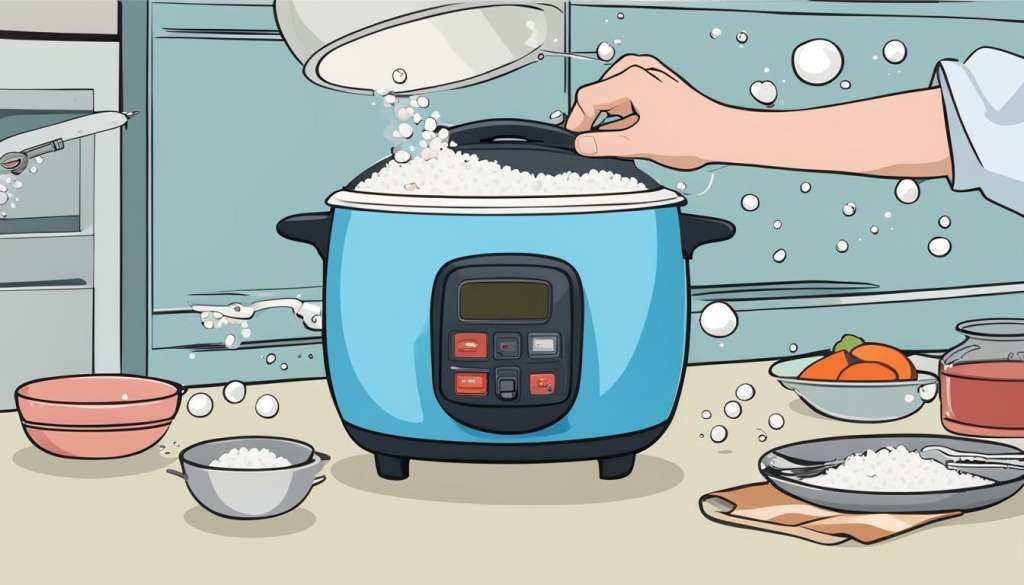
Following these maintenance tips can help ensure your rice cooker stays in good condition and functions optimally for many years to come.
Reasons Behind Excessive Bubbling
If you notice your rice cooker bubbling excessively during operation, it could be a sign of an underlying issue that needs attention. Here are some common problems that can cause excessive bubbling:
| Problem | Cause |
|---|---|
| Rice cooker overfilled with water | Adding too much water to the cooker can cause excessive bubbling. Ensure that you are using the right amount of water as per the rice cooker’s instructions. |
| Misaligned or damaged gasket | A gasket is a seal that prevents steam from escaping the cooker. If it is damaged or misaligned, it can cause excessive bubbling. Inspect the gasket for any signs of wear and tear and replace if necessary. |
| Dirty rice cooker | If your rice cooker is dirty, particularly the heating plate, it can cause bubbling due to the buildup of impurities. Clean your rice cooker regularly to prevent this issue. |
| Low-quality rice | Cheap or low-quality rice can result in excessive bubbling due to the excess starch content. Using high-quality rice can alleviate this issue. |
If you have identified the problem that is causing your rice cooker to bubble excessively, you can take steps to address it. If the issue persists, it may be time to replace your cooker with a new one to ensure optimal performance.
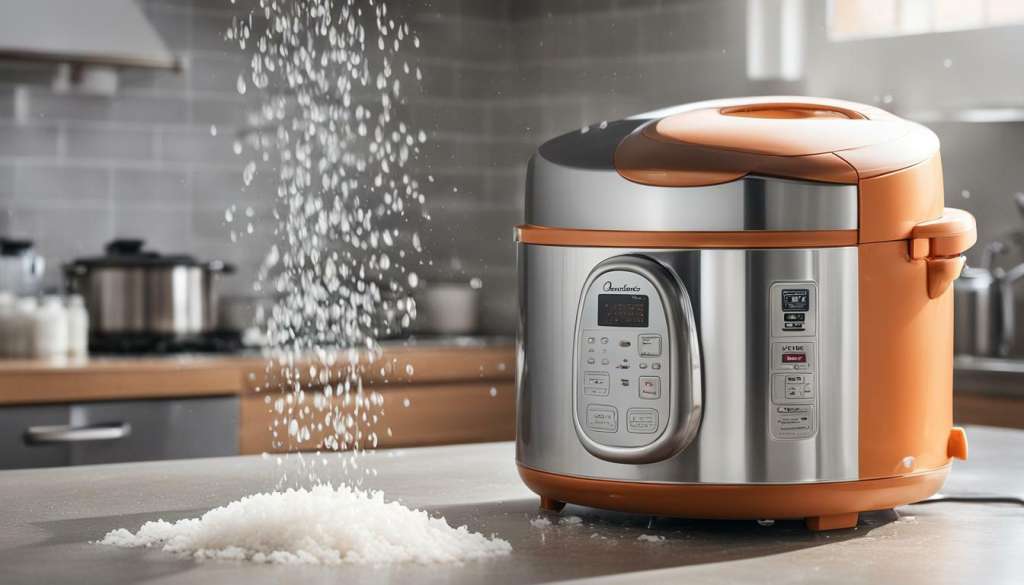
Troubleshooting for Bubbling Rice Cookers
If your rice cooker is bubbling excessively, there are a few troubleshooting steps you can take to resolve the issue. First, check that you have added the correct amount of water and rice to the cooker. Too much or too little water can cause bubbling. If the problem persists, make sure the cooker is on a level surface and not tilted.
Another common reason for bubbling is a faulty thermostat. If this is the case, the cooker may not be able to regulate the temperature properly. To check if this is the issue, unplug the cooker and let it cool down completely. Then, plug it back in and turn it on. If it starts bubbling immediately, the thermostat may need to be replaced.
If the above steps do not solve the problem, the issue may be with the heating element. Over time, the element may become damaged or burnt out, causing the cooker to bubble excessively. In this case, it is best to consult a professional for repair or replacement.
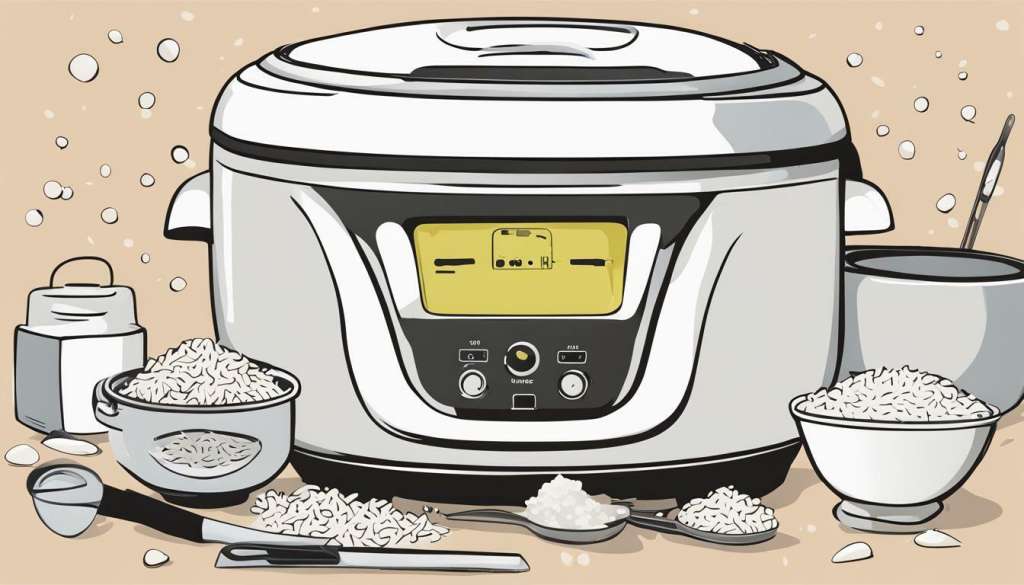
Remember that proper maintenance is key to preventing issues with your rice cooker. Regularly cleaning the cooker and checking for any signs of wear and tear can help ensure optimal performance. If your rice cooker is still not working properly after trying these troubleshooting steps, it may be time to invest in a new one.
Maintenance Tips for Optimal Rice Cooker Performance
Now that we have discussed common problems with rice cookers, it’s important to know how to maintain your rice cooker for optimal performance. Here are some essential maintenance tips to ensure that your rice cooker operates correctly:
- Regular cleaning: It is important to clean your rice cooker after every use. Clean the inner pan and lid thoroughly with a soft sponge or cloth. Use a mild detergent if necessary, but avoid using steel wool or abrasive cleaners that could damage the non-stick coating.
- Descale the rice cooker: If you live in an area with hard water, mineral buildup may occur inside the rice cooker. To descale the rice cooker, add a mixture of equal parts water and vinegar to the inner pan and allow it to soak for an hour. Then, rinse the inner pan with water and dry it completely.
- Store properly: Always store your rice cooker in a cool, dry place. Avoid keeping it near heat sources or in direct sunlight, as this can damage the inner components.
- Regular inspection: Check the power cord and plug for any damage regularly. If you find any damage, replace them immediately to avoid any unexpected accidents.
By following these maintenance tips, you can prolong the life of your rice cooker and ensure that it functions properly for years to come.
Image related to Rice Cooker Maintenance Tips
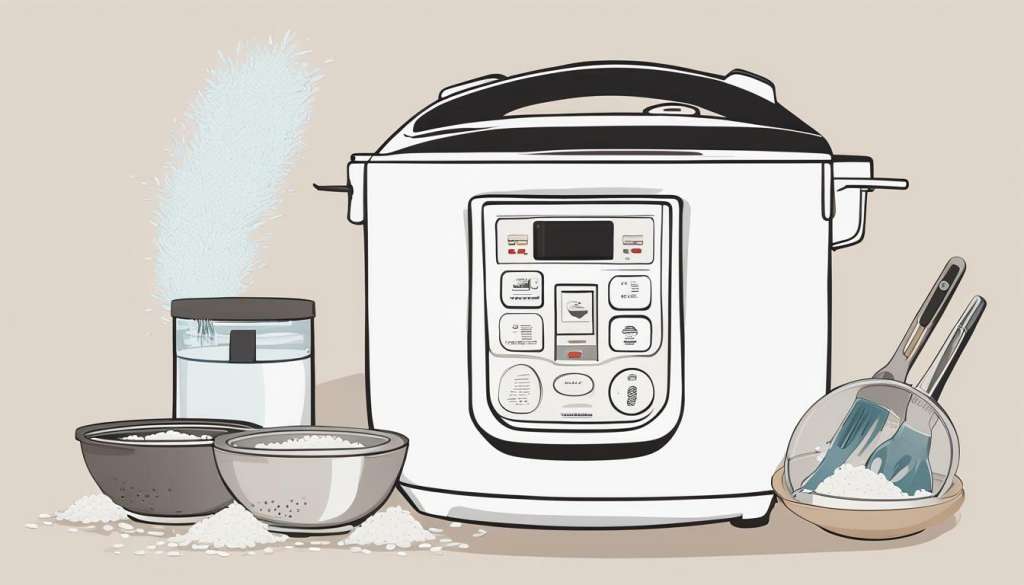
If you encounter any problems with your rice cooker after performing regular maintenance, it may be time to seek professional help. Rice cooker repairs can be costly, so it’s best to maintain your rice cooker regularly to avoid common problems before they occur.
Frequently Asked Questions
As with any kitchen appliance, rice cookers can present some confusion for those not familiar with their operation. Here are some of the most frequently asked questions about rice cooker bubbling issues:
| Question | Answer |
|---|---|
| Why is my rice cooker bubbling? | Rice cookers operate by heating up water to steam the rice. As the water boils, it can create bubbles that rise to the surface, resulting in visible bubbling. This is a normal part of the cooking process and should not cause any concern. |
| My rice cooker is bubbling excessively. Is this normal? | While some bubbling is expected during operation, excessive bubbling may be an indication of a problem with your rice cooker. Refer to the troubleshooting section for tips on resolving this issue. |
| Should I remove the lid when my rice cooker is bubbling? | It is recommended to leave the lid on during the cooking process to prevent the steam from escaping. Removing the lid may result in unevenly cooked rice. |
| Can I add more water to my rice cooker if it is bubbling too much? | Adding more water to the rice cooker may exacerbate the bubbling problem. Refer to the troubleshooting section for tips on resolving the issue. |
If you have any other concerns or questions regarding your rice cooker, consult the user manual or contact the manufacturer for assistance.
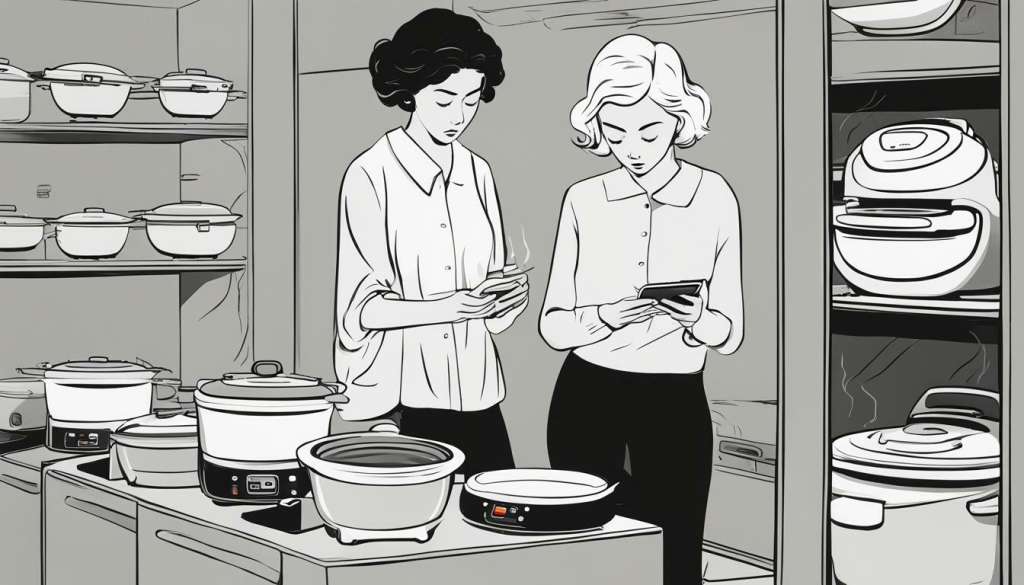
Safe Cooking Practices
When it comes to using a rice cooker, safety should be a top priority. Not only can a malfunctioning rice cooker lead to poor cooking results, but it can also be a potential fire hazard. Here are some rice cooker maintenance tips and safe cooking practices to keep in mind:
- Always read the manufacturer’s instructions and follow them carefully.
- Ensure that the rice cooker is placed on a stable and level surface.
- Never leave the rice cooker unattended while it is in use.
- Keep the rice cooker away from children and pets.
- Do not touch the hot surfaces of the rice cooker while it is in use.
- Always use the appropriate amount of water and rice, as specified in the instructions.
- Do not add any ingredients other than rice and water to the rice cooker.
- After cooking is complete, unplug the rice cooker and allow it to cool before cleaning.
- Regularly clean the rice cooker to prevent the buildup of food residue.
By following these rice cooker maintenance tips and safe cooking practices, you can ensure that your rice cooker is working properly and minimize the risk of accidents in the kitchen.
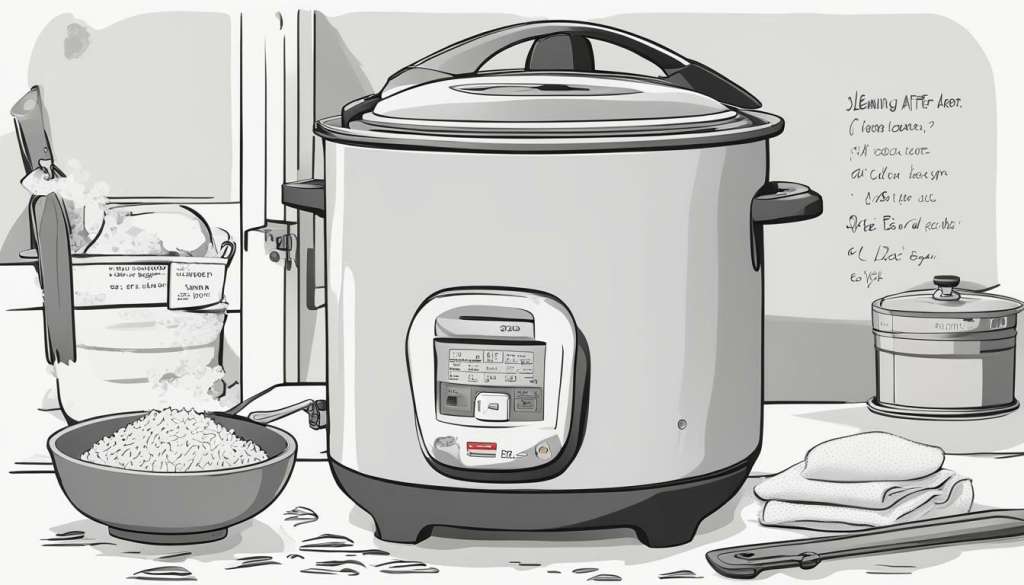
Troubleshooting Steps for Bubbling Rice Cookers
If you are experiencing bubbling issues with your rice cooker, don’t fret. Here are some simple troubleshooting steps you can follow:
- Check the water level: Make sure you are using the correct amount of water for the type and amount of rice you are cooking. Too much water can cause bubbling.
- Clean the rice cooker: A dirty or greasy rice cooker can also cause bubbling. Clean the inner pot thoroughly before using it.
- Check the seal: Make sure the seal on the lid is tight and secure. An improperly sealed lid can cause excess steam to escape, leading to bubbles.
- Inspect the heating plate: Check the heating plate for any damage or defects. A damaged heating plate can cause uneven heating, leading to bubbles.
- Adjust the temperature: If your rice cooker has a temperature control function, adjust it to a lower setting. High temperatures can cause bubbling.
By following these troubleshooting steps, you should be able to resolve most bubbling issues with your rice cooker.
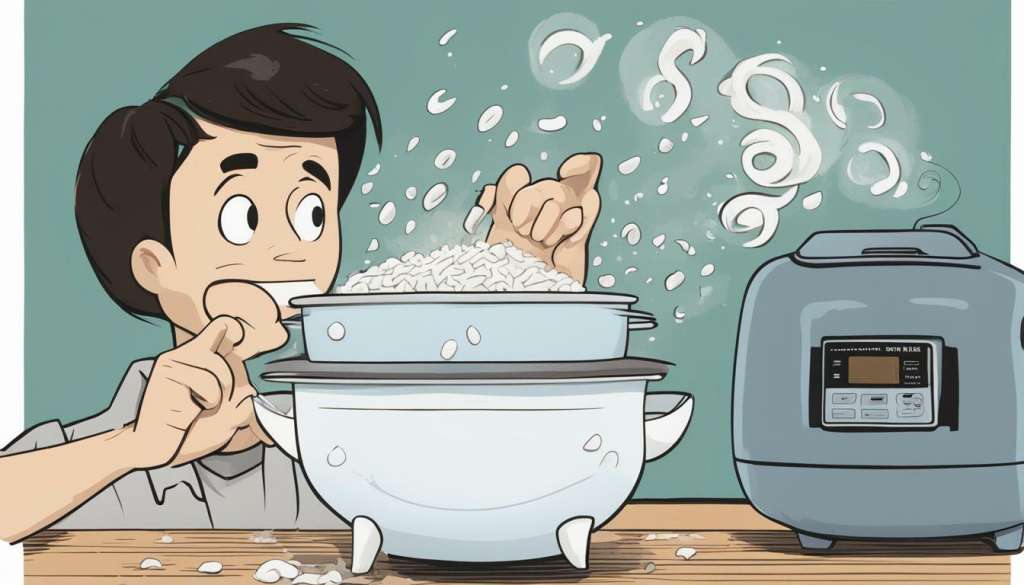
However, if the problem persists, it may be time to contact the manufacturer or take your rice cooker to a professional for repair.
Maintaining a Healthy Rice Cooker
Like any other kitchen appliance, rice cookers require regular maintenance to function optimally. Here are a few tips to keep your rice cooker in top condition:
- Clean after every use: Rice cookers should be cleaned after every use to prevent any leftover rice from hardening and reducing the effectiveness of the heating element. Simply remove the inner pot and wash with warm soapy water before rinsing it out and reassembling.
- Inspect the power cord: Ensure that the cord is not frayed or damaged. Damaged cords can lead to electrical fires or malfunctioning.
- Avoid using abrasive cleaners: Avoid using abrasive cleaners or steel wool on the inner pot as this can cause scratches that will make it difficult to clean and damage the non-stick coating. Instead, use a non-abrasive sponge or cloth with mild detergent.
- Keep the cooker dry: Ensure that the inner pot and the heating element are completely dry before using the rice cooker. Operating a wet rice cooker can cause electrical shocks and damage the appliance.
- Store the rice cooker properly: Store the rice cooker in a dry, cool place away from direct sunlight to avoid damaging the electrical components.
Regular maintenance will not only keep your rice cooker functioning effectively but it can also increase the lifespan of the appliance, saving you money in the long run.

How to Prevent Rice Cooker Bubbling Issues
Preventing rice cooker bubbling issues is key to ensuring your rice cooker operates optimally. Here are some tips to help you prevent rice cooker bubbling problems:
- Clean your rice cooker regularly. Rice cookers that are not cleaned regularly may have leftover rice starch in the bottom of the pot which can cause bubbling. Clean your rice cooker after every use and wipe down the interior with a damp cloth.
- Measure your rice and water accurately. Adding too much water can cause bubbling, so make sure to measure your rice and water correctly according to the manufacturer’s instructions.
- Use the right type of rice. Different types of rice may require different amounts of water. Check the instructions for your rice cooker to make sure you’re using the correct type of rice.
- Don’t overload your rice cooker. Overfilling your rice cooker can cause bubbling and may damage the cooker. Make sure to follow the manufacturer’s instructions for the maximum amount of rice that can be cooked in your rice cooker.
- Place the lid on correctly. If the lid is not on correctly, steam may escape from the rice cooker, causing bubbling. Make sure to place the lid on correctly according to the manufacturer’s instructions.
By following these preventive measures, you can ensure that your rice cooker does not have bubbling problems and works efficiently for a long time.

Conclusion
Now that you have a better understanding of rice cooker operations, you can confidently troubleshoot bubbling issues and maintain your appliance for optimal performance. Remember to always prioritize safety and follow recommended maintenance tips to prevent common rice cooker problems.
If you do encounter issues with bubbling, don’t panic. Our step-by-step troubleshooting guide can help you identify and resolve the problem. And, to prevent future bubbling issues, make sure to follow our preventive measures.
By taking these steps and maintaining a healthy rice cooker, you can ensure delicious and perfectly cooked rice every time. Happy cooking!
FAQ
Q: Is it normal for my rice cooker to bubble while cooking?
A: Yes, it is normal for a rice cooker to bubble while cooking. The bubbling is a result of the boiling water and steam created during the cooking process.
Q: Why does my rice cooker bubble excessively?
A: Excessive bubbling in a rice cooker can be caused by factors such as using too much water, overfilling the cooker, or a malfunctioning pressure valve. Make sure to follow the manufacturer’s instructions and check for any issues with your specific rice cooker model.
Q: How can I troubleshoot bubbling issues with my rice cooker?
A: To troubleshoot bubbling issues with your rice cooker, you can try adjusting the amount of water used, ensuring the cooker is not overfilled, and checking the pressure valve for any blockages. If the problem persists, refer to the manufacturer’s manual or contact their customer support for further assistance.
Q: What are some safety tips for using a rice cooker?
A: When using a rice cooker, it is important to read and follow the manufacturer’s instructions, avoid overfilling the cooker, and ensure proper ventilation. Additionally, always unplug the cooker when not in use and handle it with caution to prevent burns or other accidents.
Q: How do I properly maintain my rice cooker?
A: To maintain your rice cooker, regularly clean it according to the manufacturer’s instructions, avoid using abrasive materials that may damage the non-stick coating, and periodically check and clean the pressure valve and other removable parts. Proper maintenance can help ensure optimal performance and prolong the lifespan of your rice cooker.


